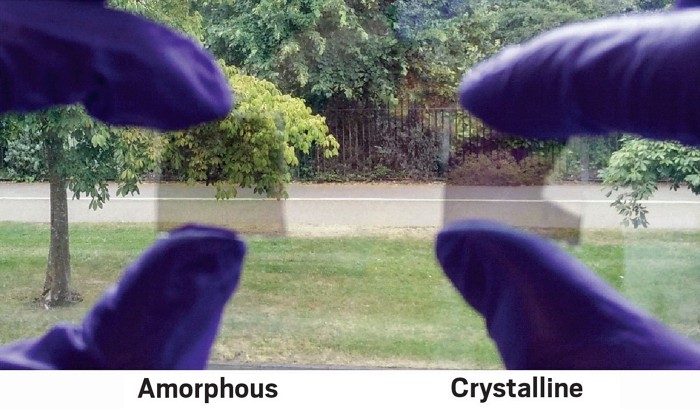
Anew window coating absorbs the sun’s warm near-infrared rays in the winter and reflects them in the summer while keeping the glass transparent (ACS Photonics 2021, DOI: 10.1021/acsphotonics.1c01128). Windows with the switchable glaze could cut the energy use of a house by up to 25% compared with windows used in new construction today.
Energy-efficient windows could play a key role in reducing the energy needed to heat and cool buildings, which makes up more than one-fifth of all the energy used by developed countries. Today’s efficient windows have two glass panes with low-emissivity coatings that improve insulation by preventing heat transfer. Smart windows that can be electrically triggered to darken and block the sun’s visible and near-IR light are also now on the market.
But smart windows that remain see-through would be more desirable to building inhabitants, which inspired Nathan Youngblood of the University of Pittsburgh, Harish Bhaskaran of the University of Oxford, and their colleagues to make the new coating. Their ultrathin material heats or cools a building’s interior without affecting visibility by absorbing or reflecting the sun’s near-IR rays. “The unique twist on smart windows is that the visible light transmission is pretty much unchanged,” Youngblood says, “so it is energy-saving, aesthetically pleasing, and also provides thermal benefits.”
The heart of the coating is a 12 nm layer of a phase-change material, Ge20Te80, which can switch reversibly from a crystalline to an amorphous state when heated to 280–450 °C. As a proof-of-concept, the researchers deposited the coating on 25.8 cm2 samples of glass. For commercial, double-pane windows, they propose putting it on the outside-facing side of the interior pane of glass.
Using transparent heating wires integrated on the glass sample, they showed that the glaze could be switched to the amorphous state, which reflects the sun’s near-IR energy. In the crystalline state, the coating absorbs the energy, which is transferred to the silica glass window and radiated into the building as heat. The transparency changes by only 10% between the two states.
The coating’s performance depends on the amount of near-IR solar energy it can harvest or reflect, so the researchers also modeled how much energy the window would save when used in nine different geographical areas around the globe. Compared with commercially available double-pane windows, the glazed windows cut energy use by 8–25%, working better in sunnier climates. Those calculations took into account the energy required to control the phase-change material’s state.
Still, Youngblood admits “the material is not ready for primetime yet” because of the high temperatures it needs. The material can also be controlled using electrical pulses, but that would take a lot of power for large windows, he says. “Future work would be to reduce the amount of heat it takes to switch between states” by doping the materials to reduce switching temperature, he adds.
The glaze’s ability to convert IR radiation to heat without affecting transparency is “a much-coveted feature,” says Juejun Hu, a materials scientist and engineer at MIT. The technology would be even more promising if the researchers could further improve visible transmission with improved material and layer designs, he says. “I would like to see the technology being scaled to actual windows.”



